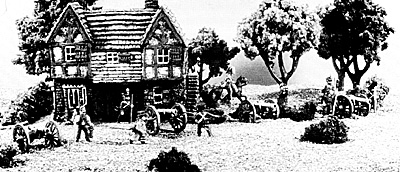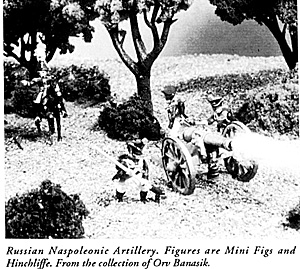 The purpose of artillery in the era of linear tactics is the infliction of casualties, especially at extended distances. The effective range of most
artillery pieces in the Napoleonic period approximated 900 yards,
averaging one round per minute under battlefield conditions and 1 to 1 1/2
casualties per round fired. Casualties inflicted while defending a direct
attack on the artillery position would be considerably larger, causing
approximately 20 to 70 per gun, against cavalry and infantry respectively.
The purpose of artillery in the era of linear tactics is the infliction of casualties, especially at extended distances. The effective range of most
artillery pieces in the Napoleonic period approximated 900 yards,
averaging one round per minute under battlefield conditions and 1 to 1 1/2
casualties per round fired. Casualties inflicted while defending a direct
attack on the artillery position would be considerably larger, causing
approximately 20 to 70 per gun, against cavalry and infantry respectively.
French Napoleonic Artillery. Figures are Dixon and Minifig; building is Hovel's Inn. From the collection of Orv Banasik.
The high rate of casualties caused by cannister would make the casualty ratio of round shot in the realm of 1/2 to 1 casualty per expended round, far below the battlefield average of 1 to 1 1/2 casualties per round. Large artillery pieces, eight-pounder or larger, also had a boosting effect on the morale of nearby friendly formations and a detrimental effect on the morale of opposing formations.
When on the defensive, artillery is best placed to assist at all points of the defensive perimeter. In this manner, it is available to immediately respond to any enemy approach without delay. Infantry and artillery formations both maneuver at approximately 100 yards per minute, therefore, an artillery formation would have only fifteen minutes to limber, move, and unlimber, relocating to defense an infantry attack that was first observed 1500 yards from the defensive perimeter; a cavalry attack can cover the same 1500 yards in less than 6 1/2 minutes, eliminating any possibility of artillery relocation. Placement of the batteries must be in front of the forward line of defense, providing a clear field-of-fire, allowing flanking fire against enemy formations that advance by, without directly engaging, the artillery battery; fire from the flanks inflicts devastating morale effects and casualties on targeted formations. The forward placement of artillery also allows the engagement of enemy formations at greater distances, prolonging the period during which they are under fire (e.g. if the battery was 200 yards behind the defensive perimeter, the interval of engagement would be limited to 700 yards and preclude the crushing use of cannister and flanking fire).
The horizontal flight of round shot continues at man-height or less for the entire distance of its travel, therefore, fire at a target at the same level is not sensitive to errors made in judging the distance to the target formation. Artillery positions at higher levels will be less effective, because plunging fire has a tendency to bury itself, eliminating the extension of range caused by ricochets, and are sensitive to errors in judging the distance to the targeted formation. Fire from above is sensitive to small errors in elevation, which result in the round burying behind or in front of the targeted formation. In addition, the excessive depressing of an artillery piece could result in the overturning of the piece upon firing, the upward force of the recoil driving the carriage over upon itself.
Horse artillery is better suited to the role of artillery reserve, being more mobile than foot artillery, and the majority of these pieces should be located in said reserve, in order to be available to quickly respond wherever it is required. The reserve artillery should be placed in a position such that it can move in every direction, unhindered by terrain or formations. Any hindrance to the movement of reserves can waste valuable minutes in the race to gain the advantage of the ebb and flow of battle.
Foot artillery, being less mobile, should have the majority of pieces placed in the front defensive line. Located in evenly distributed positions along the defensive perimeter and lacking the time to respond to enemy deployments, foot guns should be placed in positions that provide protection from enemy fire and approach. Positioning artillery pieces behind a glacis, causes enemy artillery rounds to skip over the position or bury themselves in the earth; positioning behind soft ground, artillery rounds will bury themselves and enemy approach will be delayed or prevented. Artillery formations are not capable of holding their ground against a concerted infantry or cavalry attack; the French cavalry charges at Waterloo being one of the better known examples of artillery positions being repeatedly overrun, having artillerymen cover in nearby squares and return to their guns unharmed when the attacking cavalry withdrew.
 Russian Napoleonic Artillery. Figures are Mini Figs and
Hinchliffe. From the collection of Orv Banasik.
Russian Napoleonic Artillery. Figures are Mini Figs and
Hinchliffe. From the collection of Orv Banasik.
The providing of infantry and cavalry as protection against enemy approach is as important as the placement of the batteries themselves; supporting formations (infantry squares being preferable) must be placed close to the artillerymen, allowing the artillery to fire until the last minute before covering in the friendly formation.
On the offensive, a mass of artillery should be assembled to direct their fire upon the point in the enemy fine toward which the attack will be aimed; the bombardment must be given sufficient time to weaken the morale and combat efficiency of the target formation to a measurable degree. Some artillery should advance with the attacking formations to provide close fire support (i.e. French artillery, advancing with attacking formations, advanced their posidon to within 100 yards of Russian positions at Friedland). The artillery that advances with the attack should be limited to light foot and horse artillery, supporting foot artillery can be left in positions with the object of providing long range supporting fire.
The massed cavalry charge presents the ideal opportunity for supporting artillery formations, reacting to the immanent approach of cavalry - the opposing infantry form squares. These immobile targets pose no threat to the artillery, presenting large immobile non-threatening targets which are ripe for the picking with dose range cannister or penetrating round shot - as many as 40 men have been recorded to have died from a single round shot which struck such a target.
If available in large numbers, massed batteries can be formed that allow artillery to become an independent military arm, rather than a supporting arm to infantry or cavalry; these formations contain enough artillery tubes to maintain a continuous barrage sufficiently deadly to prevent the approach of enemy formations thereby protecting itself - and inflicting a continual drain of casualties that is so large that the integrity of the target cannot be maintained; if a battery can cause eight casual ties per minute, massing two batteries or three batteries against a single target formation would cause sixteen or twenty-four casualties per minute, respectively. An infantry battalion of 500 men could lose half of its manpower in a period of ten minutes. This tactic recurs throughout Napoleonic conflicts as demonstrated by the French: Wagram (112 guns), Borodino (250 guns), Leipzig (150 guns), and Waterloo (148 guns); the Russians at Eylau (60 and 70 guns); the English at Vittoria (75 guns).
Two-thirds of available artillery should be assigned to infantry and artillery targets; the remaining third is assigned a counterbattery mission. The offensive task of counterbattery is the distraction of defending guns - toward the attacking artillery and away ftom the advancing mass of troops. On the defensive, the counterbattery mission is to distract or destroy attacking artillery, preventing casualties from being inflicted on formations at the point of attack. The predominance of the anti- infantry/cavalry mission symbolizes the supporting nature of artillery; the opponent's artillery cannot win or lose the battle, so it deserves a minority of your attention. The enemy infantry and cavalry are the formations that will beat you - so they are assigned the majority of the available guns.
Infantry is used in the taking or holding of terrain, while cavalry's mission is the assault of disordered formations and the pursuit of retreating foes. The employment of artillery in the period of linear tactics must be that of a supporting arm; it can contribute to both the advance and defense by inflicting great casualties at the point of attack, disrupting enemy formations, and making the task of infantry and cavalry more achievable, but it cannot be expected to hold ground or destroy an enemy while acting independently, and it must be supported at all times to ensure its own survival.
BIBLIOGRAPHY
Haythornewaite, Philip J., Napoleon's Military Machine, New York, 1988
Haythornewaite, Philip J., The Napoleonic Source Book New York, 1990
Haythornewaite, Philip J., Weapons And Equipment of The Napoleonic
Wars, Poole, Dorset, 1979
Hughes, C.B., C.B.E., Major-General B. P., Firepower, London,
1974
de Jornini, Baron, Art Of War, New York, 1854
Back to Table of Contents -- Courier # 61
To Courier List of Issues
To MagWeb Master Magazine List
© Copyright 1993 by The Courier Publishing Company.
This article appears in MagWeb.com (Magazine Web) on the Internet World Wide Web.
Other articles from military history and related magazines are available at http://www.magweb.com